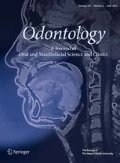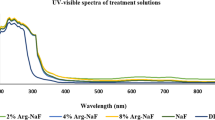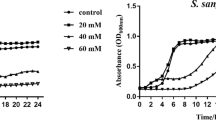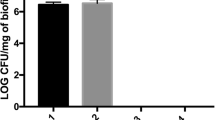Abstract
For purpose of enhancing the antibacterial activity of a universal adhesive, the antimicrobial peptide nisin was incorporated into Single Bond Universal and its antibacterial effect on Streptococcus mutans monospecific biofilms and saliva-derived multispecies biofilms was studied. Nisin was incorporated into Single Bond Universal and the antibacterial activity was examined by confocal laser scanning microscopy (CLSM), reverse transcription-quantitative polymerase chain reaction (qRT-PCR), phenol–sulfuric acid method and lactate dehydrogenase enzymatic method. The bonding properties were tested by microtensile bond strength (μTBS) and degree of conversion (DC). Data were analyzed by one-way analysis of variance (ANOVA) and least significant difference multiple comparison tests (P < 0.05). The Single Bond Universal incorporated with 3% (w/v) nisin could significantly inhibit the growth of the S. mutans monospecific biofilms (P< 0.01) and decrease the expression of genes related to extracellular polysaccharide (EPS) synthesis (gtfB, gtfC, gtfD and spaP) and acidogenicity (ldh) (P < 0.05). 3% (w/v) nisin-incorporated Single Bond Universal could also inhibit the growth of saliva-derived multispecies biofilms and decrease the excretion of EPS and lactic acid ( P< 0.05). μTBS and DC of 3% (w/v) nisin-incorporated Single Bond Universal did not deteriorate obviously (P > 0.05). In conclusion, 3% (w/v) nisin-incorporated Single Bond Universal substantially inhibited the growth of both S. mutans monospecific and saliva-derived multispecies biofilms without compromising the bonding properties.







Similar content being viewed by others
References
Tyas MJ, Anusavice KJ, Frencken JE, Mount GJ. Minimal intervention dentistry–a review. FDI Commission project 1–97. Int Dent J. 2000;50(1):1–12.
Demarco FF, Correa MB, Cenci MS, Moraes RR, Opdam NJ. Longevity of posterior composite restorations: not only a matter of materials. Dent Mater. 2012;28(1):87–101. https://doi.org/10.1016/j.dental.2011.09.003.
Elderton RJ. The prevalence of failure of restorations: a literature review. J Dent. 1976;4(5):207–10.
Van Dijken JW, Pallesen U. Posterior bulk-filled resin composite restorations: a 5-year randomized controlled clinical study. Br Dent J. 2016;221(7):409. https://doi.org/10.1038/sj.bdj.2016.731.
Moraschini V, Fai CK, Alto RM, Dos Santos GO. Amalgam and resin composite longevity of posterior restorations: a systematic review and meta-analysis. J Dent. 2015;43(9):1043–50. https://doi.org/10.1016/j.jdent.2015.06.005.
Kopperud SE, Tveit AB, Gaarden T, Sandvik L, Espelid I. Longevity of posterior dental restorations and reasons for failure. Eur J Oral Sci. 2012;120(6):539–48. https://doi.org/10.1111/eos.12004.
Dutra-Correa M, Leite A, de Cara S, Diniz IMA, Marques MM, Suffredini IB, Fernandes MS, Toma SH, Araki K, Medeiros IS. Antibacterial effects and cytotoxicity of an adhesive containing low concentration of silver nanoparticles. J Dent. 2018;77:66–71. https://doi.org/10.1016/j.jdent.2018.07.010.
Totiam P, Gonzalez-Cabezas C, Fontana MR, Zero DT. A new in vitro model to study the relationship of gap size and secondary caries. Caries Res. 2007;41(6):467–73. https://doi.org/10.1159/000107934.
Bourbia M, Ma D, Cvitkovitch DG, Santerre JP, Finer Y. Cariogenic bacteria degrade dental resin composites and adhesives. J Dent Res. 2013;92(11):989–94. https://doi.org/10.1177/0022034513504436.
Kramer N, Mohwald M, Lucker S, Domann E, Zorzin JI, Rosentritt M, Frankenberger R. Effect of microparticulate silver addition in dental adhesives on secondary caries in vitro. Clin Oral Investig. 2015;19(7):1673–81. https://doi.org/10.1007/s00784-014-1396-x.
Wu T, Li B, Zhou X, Hu Y, Zhang H, Huang Y, Xu HHK, Guo Q, Li M, Feng M, Peng X, Weir MD, Cheng L, Ren B. Evaluation of novel anticaries adhesive in a secondary caries animal model. Caries Res. 2018;52(1–2):14–21. https://doi.org/10.1159/000481832.
Zhang K, Wang S, Zhou X, Xu HH, Weir MD, Ge Y, Li M, Wang S, Li Y, Xu X, Zheng L, Cheng L. Effect of antibacterial dental adhesive on multispecies biofilms formation. J Dent Res. 2015;94(4):622–9. https://doi.org/10.1177/0022034515571416.
Brandao NL, Portela MB, Maia LC, Antonio A, Silva V, Silva EMD. Model resin composites incorporating ZnO-NP: activity against S. mutans and physicochemical properties characterization. J Appl Oral Sci. 2018;26:e20170270. https://doi.org/10.1590/1678-7757-2017-0270.
Garcia IM, Leitune VCB, Visioli F, Samuel SMW, Collares FM. Influence of zinc oxide quantum dots in the antibacterial activity and cytotoxicity of an experimental adhesive resin. J Dent. 2018;73:57–60. https://doi.org/10.1016/j.jdent.2018.04.003.
Tong Z, Ni L, Ling J. Antibacterial peptide nisin: a potential role in the inhibition of oral pathogenic bacteria. Peptides. 2014;60:32–40. https://doi.org/10.1016/j.peptides.2014.07.020.
Shin JM, Ateia I, Paulus JR, Liu H, Fenno JC, Rickard AH, Kapila YL. Antimicrobial nisin acts against saliva derived multi-species biofilms without cytotoxicity to human oral cells. Front Microbiol. 2015;6:617. https://doi.org/10.3389/fmicb.2015.00617.
Cerrutti P, Terebiznik MR, Huergo MSD, Jagus R, Pilosof AMR. Combined effect of water activity and pH on the inhibition of Escherichia coli by Nisin. J Food Prot. 2001;64(10):1510–4. https://doi.org/10.4315/0362-028x-64.10.1510.
Rollema HS, Kuipers OP, Both P, De Vos WM, Siezen RJ. Improvement of solubility and stability of the antimicrobial peptide nisin by protein engineering. Appl Environ Microbiol. 1995;61(8):2873–8.
Su M, Yao S, Gu L, Huang Z, Mai S. Antibacterial effect and bond strength of a modified dental adhesive containing the peptide nisin. Peptides. 2018;99:189–94. https://doi.org/10.1016/j.peptides.2017.10.003.
Huang X, Zhang K, Deng M, Exterkate RAM, Liu C, Zhou X, Cheng L, Ten Cate JM. Effect of arginine on the growth and biofilm formation of oral bacteria. Arch Oral Biol. 2017;82:256–62. https://doi.org/10.1016/j.archoralbio.2017.06.026.
Munoz MA, Luque I, Hass V, Reis A, Loguercio AD, Bombarda NH. Immediate bonding properties of universal adhesives to dentine. J Dent. 2013;41(5):404–11. https://doi.org/10.1016/j.jdent.2013.03.001.
Mena-Serrano A, Kose C, De Paula EA, Tay LY, Reis A, Loguercio AD, Perdigao J. A new universal simplified adhesive: 6-month clinical evaluation. J Esthet Restor Dent. 2013;25(1):55–69. https://doi.org/10.1111/jerd.12005.
Xie T, Liao Z, Lei H, Fang X, Wang J, Zhong Q. Antibacterial activity of food-grade chitosan against Vibrio parahaemolyticus biofilms. Microb Pathog. 2017;110:291–7. https://doi.org/10.1016/j.micpath.2017.07.011.
Wang Y, Wang X, Jiang W, Wang K, Luo J, Li W, Zhou X, Zhang L. Antimicrobial peptide GH12 suppresses cariogenic virulence factors of Streptococcus mutans. J Oral Microbiol. 2018;10(1):1442089. https://doi.org/10.1080/20002297.2018.1442089.
Zeng H, Liu J, Ling J. Efflux inhibitor suppresses Streptococcus mutans virulence properties. FEMS Microbiol Lett. 2017. https://doi.org/10.1093/femsle/fnx033.
Cao L, Zhang ZZ, Xu SB, Ma M, Wei X. Farnesol inhibits development of caries by augmenting oxygen sensitivity and suppressing virulence-associated gene expression inStreptococcus mutans. J Biomed Res. 2017;31(4):333–43. https://doi.org/10.7555/jbr.31.20150151.
Zhou Y, Millhouse E, Shaw T, Lappin DF, Rajendran R, Bagg J, Lin H, Ramage G. Evaluating Streptococcus mutans Strain Dependent Characteristics in a Polymicrobial Biofilm Community. Front Microbiol. 2018;9:1498. https://doi.org/10.3389/fmicb.2018.01498.
Kolderman E, Bettampadi D, Samarian D, Dowd SE, Foxman B, Jakubovics NS, Rickard AH. L-arginine destabilizes oral multi-species biofilm communities developed in human saliva. PLoS One. 2015;10(5):e0121835. https://doi.org/10.1371/journal.pone.0121835.
Masuko T, Minami A, Iwasaki N, Majima T, Nishimura S, Lee YC. Carbohydrate analysis by a phenol-sulfuric acid method in microplate format. Anal Biochem. 2005;339(1):69–72. https://doi.org/10.1016/j.ab.2004.12.001.
Sauro S, Osorio R, Watson TF, Toledano M. Assessment of the quality of resin-dentin bonded interfaces: an AFM nano-indentation, muTBS and confocal ultramorphology study. Dent Mater. 2012;28(6):622–31. https://doi.org/10.1016/j.dental.2012.02.005.
Thanaratikul B, Santiwong B, Harnirattisai C. Self-etch or etch-and-rinse mode did not affect the microshear bond strength of a universal adhesive to primary dentin. Dent Mater J. 2016;35(2):174–9. https://doi.org/10.4012/dmj.2015-109.
Eshmawi YT, Al-Zain AO, Eckert GJ, Platt JA. Variation in composite degree of conversion and microflexural strength for different curing lights and surface locations. J Am Dent Assoc. 2018;149(10):893–902. https://doi.org/10.1016/j.adaj.2018.06.004.
Mai S, Mauger MT, Niu LN, Barnes JB, Kao S, Bergeron BE, Ling JQ, Tay FR. Potential applications of antimicrobial peptides and their mimics in combating caries and pulpal infections. Acta Biomater. 2017;49:16–35. https://doi.org/10.1016/j.actbio.2016.11.026.
Hagiwara A, Imai N, Nakashima H, Toda Y, Kawabe M, Furukawa F, Delves-Broughton J, Yasuhara K, Hayashi SM. A 90-day oral toxicity study of nisin A, an anti-microbial peptide derived from Lactococcus lactis subsp. lactis, in F344 rats. Food Chem Toxicol. 2010;48(8–9):2421–8. https://doi.org/10.1016/j.fct.2010.06.002.
Tong Z, Dong L, Zhou L, Tao R, Ni L. Nisin inhibits dental caries-associated microorganism in vitro. Peptides. 2010;31(11):2003–8. https://doi.org/10.1016/j.peptides.2010.07.016.
Tong Z, Zhou L, Jiang W, Kuang R, Li J, Tao R, Ni L. An in vitro synergetic evaluation of the use of nisin and sodium fluoride or chlorhexidine against Streptococcus mutans. Peptides. 2011;32(10):2021–6. https://doi.org/10.1016/j.peptides.2011.09.002.
Tong Z, Zhang L, Ling J, Jian Y, Huang L, Deng D. An in vitro study on the effect of free amino acids alone or in combination with nisin on biofilms as well as on planktonic bacteria of Streptococcus mutans. PLoS One. 2014;9(6):e99513. https://doi.org/10.1371/journal.pone.0099513.
Shin JM, Gwak JW, Kamarajan P, Fenno JC, Rickard AH, Kapila YL. Biomedical applications of nisin. J Appl Microbiol. 2016;120(6):1449–65. https://doi.org/10.1111/jam.13033.
Li M, Huang R, Zhou X, Qiu W, Xu X, Gregory RL. Effect of nicotine on cariogenic virulence of Streptococcus mutans. Folia Microbiol (Praha). 2016;61(6):505–12. https://doi.org/10.1007/s12223-016-0465-8.
Selwitz RH, Ismail AI, Pitts NB. Dental caries. The Lancet. 2007;369(9555):51–9. https://doi.org/10.1016/S0140-6736(07)60031-2.
Klein MI, Hwang G, Santos PH, Campanella OH, Koo H. Streptococcus mutans-derived extracellular matrix in cariogenic oral biofilms. Front Cell Infect Microbiol. 2015;5:10. https://doi.org/10.3389/fcimb.2015.00010.
Sutherland IW. Biofilm exopolysaccharides: a strong and sticky framework. Microbiology. 2001;147(1):3–9. https://doi.org/10.1099/00221287-147-1-3.
Xiao J, Klein MI, Falsetta ML, Lu B, Delahunty CM, Yates JR 3rd, Heydorn A, Koo H. The exopolysaccharide matrix modulates the interaction between 3D architecture and virulence of a mixed-species oral biofilm. PLoS Pathog. 2012;8(4):e1002623. https://doi.org/10.1371/journal.ppat.1002623.
Banas JA. Virulence properties of Streptococcus mutans. Front Biosci. 2004;9:1267–77.
Kuramitsu HK, He X, Lux R, Anderson MH, Shi W. Interspecies interactions within oral microbial communities. Microbiol Mol Biol Rev. 2007;71(4):653–70. https://doi.org/10.1128/mmbr.00024-07.
Peschel A, Sahl HG. The co-evolution of host cationic antimicrobial peptides and microbial resistance. Nat Rev Microbiol. 2006;4(7):529–36. https://doi.org/10.1038/nrmicro1441.
Smith RN, Andersen RN, Kolenbrander PE. Inhibition of intergeneric coaggregation among oral bacteria by cetylpyridinium chloride, chlorhexidine digluconate and octenidine dihydrochloride. J Periodontal Res. 1991;26(5):422–8.
Salz U, Mucke A, Zimmermann J, Tay FR, Pashley DH. pKa value and buffering capacity of acidic monomers commonly used in self-etching primers. J Adhes Dent. 2006;8(3):143–50.
Chan KM, Tay FR, King NM, Imazato S, Pashley DH. Bonding of mild self-etching primers/adhesives to dentin with thick smear layers. Am J Dent. 2003;16(5):340–6.
Arslan S, Ertas H, Zorba YO. Effect of a plant-based hemostatic agent on microleakage of self-etching adhesives. Med Oral Patol Oral Cir Bucal. 2013;18(1):e124–9.
Meerbeek BV, Yoshihara K, Yoshida Y, Mine A, De MJ, Van LKL. State of the art of self-etch adhesives. Dent Mater. 2011;27(1):17–28.
Pashley DH, Tay FR, Breschi L, Tjäderhane L, Carvalho RM, Carrilho M, Tezvergil-Mutluay A. State of the art etch-and-rinse adhesives. Dent Mater. 2011;27(1):1–16.
Wendl B, Droschl H, Kern W. A comparative study of polymerization lamps to determine the degree of cure of composites using infrared spectroscopy. Eur J Orthod. 2004;26(5):545–51.
Okuda K, Zendo T, Sugimoto S, Iwase T, Tajima A, Yamada S, Sonomoto K, Mizunoe Y. Effects of bacteriocins on methicillin-resistant Staphylococcus aureus biofilm. Antimicrob Agents Chemother. 2013;57(11):5572–9. https://doi.org/10.1128/aac.00888-13.
Acknowledgements
This study was supported by the National Natural Science Foundation of China (Grant No. 81873712) and the Science Foundation of Guangzhou (Grant No. 201904010057).
Author information
Authors and Affiliations
Corresponding authors
Ethics declarations
Conflict of interest
The authors declare that they have no conflict of interest.
Ethical approval
All procedures performed in studies involving human participants were in accordance with the ethical standards of the Hospital of Stomatology, Sun Yat-sen University (Grant No. ERC-[2016]-43) and with the 1964 Helsinki Declaration and its later amendments.
Informed consent
Informed consent was obtained from all individual participants included in the study.
Additional information
Publisher's Note
Springer Nature remains neutral with regard to jurisdictional claims in published maps and institutional affiliations.
Rights and permissions
About this article
Cite this article
Zhao, M., Qu, Y., Liu, J. et al. A universal adhesive incorporating antimicrobial peptide nisin: effects on Streptococcus mutans and saliva-derived multispecies biofilms. Odontology 108, 376–385 (2020). https://doi.org/10.1007/s10266-019-00478-8
Received:
Accepted:
Published:
Issue Date:
DOI: https://doi.org/10.1007/s10266-019-00478-8




